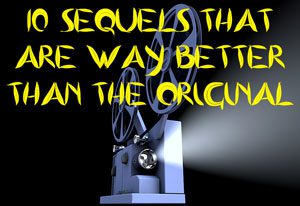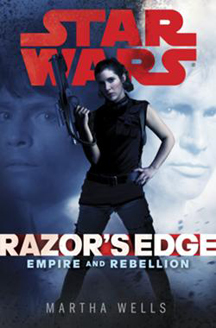I was intrigued by the idea of the “Empire and Rebellion” series, a loose thematic trilogy featuring novels focusing on each of the three main characters between Episodes IV and V. I can’t say no to a good Han Solo novel, Luke has been underexplored in novels of this time period, and Princess Leia had never been the focus of a book.
“Razor’s Edge,” the 2013 Leia novel by “Star Wars” newcomer Martha Wells, should’ve been a blast, but it’s a slog. It has too many characters, too many spaceships, and it’s pretty much non-stop unengaging and confusing action. Wells comes up with a couple good settings – a tunnel-filled pirate asteroid and a planet that inexplicably blocks ships’ sensors – but doesn’t do much with them.
Wells skirts the edges of interesting ideas, notably Leia’s feelings about her destroyed home planet of Alderaan. As famously parodied by “Family Guy,” we don’t see Leia mourn Alderaan in “A New Hope” (even though she consoles Luke about Ben’s death). In “Razor’s Edge,” Luke and Han, not to mention Leia herself, observe that Leia bottles up her feelings about Alderaan. Even when dealing with the group of Alderaanian pirates – who harbor some bizarre idea that they are fighting for justice – Leia (and Wells) doesn’t delve deeply into her feelings.
This is a big missed opportunity. Even with all the “Star Wars” stories out there, Leia’s relationship with the father and mother who raised her and shaped her worldview is underexplored. Perhaps a pre-“A New Hope” Leia trilogy in the vein of A.C. Crispin’s “Han Solo Trilogy” would be cool. Although some stories – notably Brian Daley’s “A New Hope” radio drama – have featured Leia and her dad, Bail Organa, only die-hard fans even know the name of Leia’s mom (Breha), and there aren’t any notable stories about the daughter-mother relationship.
While “Razor’s Edge” doesn’t contradict established continuity (unlike, arguably, Dark Horse’s “In the Shadow of Yavin” arc, which inexplicably has Leia as a more competent X-wing pilot than Wedge!), it doesn’t fully take advantage of this time period. Granted, it touches upon Leia’s conflict of duty: She wants to take action in the field, and the Rebel Alliance brass wants her as more of a figurehead. Stories set in this time frame – the Marvel comics, the newspaper strips – showed her doing a bit of both, but “Razor’s Edge” misses a chance to articulate how mission assignments are doled out.
The book includes Mon Mothma, General Madine and General Willard, but they don’t do much of anything. I get the impression that Leia pretty much does what she wants and the brass doesn’t challenge her on it, but this doesn’t seem quite right considering how critical Leia is of other rebels, notably Han, who behave that way. (If it’s a hypocritical aspect of Leia’s personality, well, that would be interesting to delve into.)

Considering how much danger the characters encounter here (everyone gets beat up to a degree that would please Troy Denning and Karen Miller), it might’ve been a good chance to have Leia injure her leg. In Issue 35 of the Marvel run, Leia is shown with an injured leg to explain why she’s unavailable for a mission, and the editor’s note says the injury happened in “a mission we’ve yet to chronicle.” How cool would it have been if “Razor’s Edge” were the mission?
While Wells gets the characterizations of the main characters mostly right, she does it in a clunky way, with lots of Han-Leia banter in the same vein as the Hoth ice cavern scene. And while there are a ton of supporting characters, none of them stand out; I felt like the author was fascinated by this supporting cast but failed to communicate why I should care.
The difficult-to-read “Razor’s Edge” is for “Star Wars” die-hards only. Thankfully, because this is a thematic series rather than a strict trilogy, you won’t need to read it in order to enjoy the next entry, the Han Solo novel “Honor Among Thieves” (by James S.A. Corey, March 4), which will actually take place before this one.

